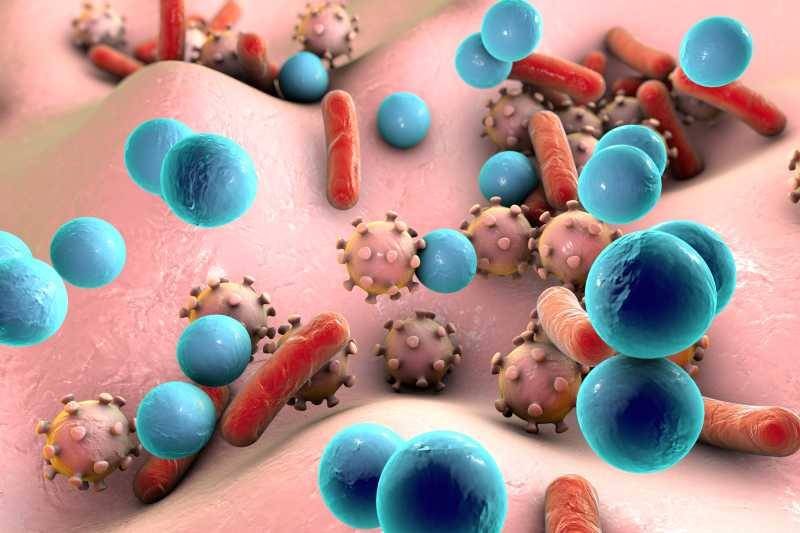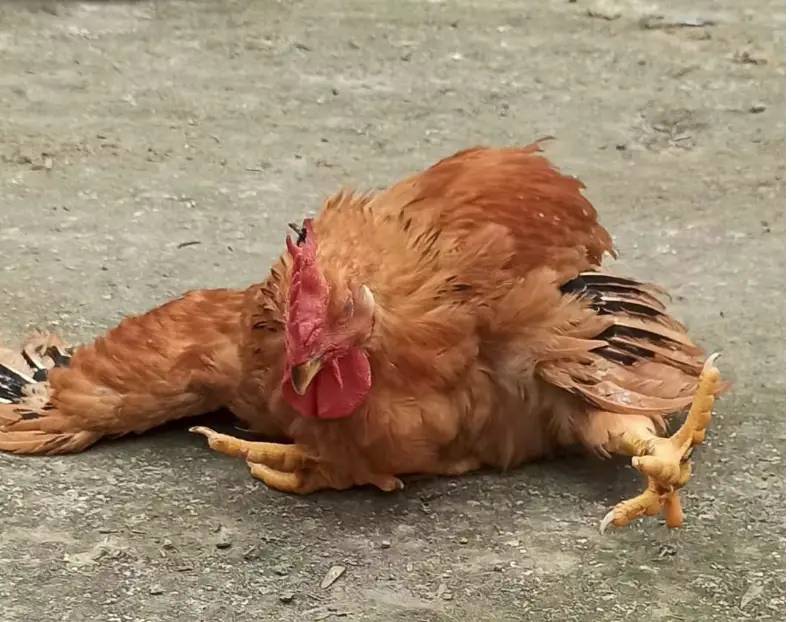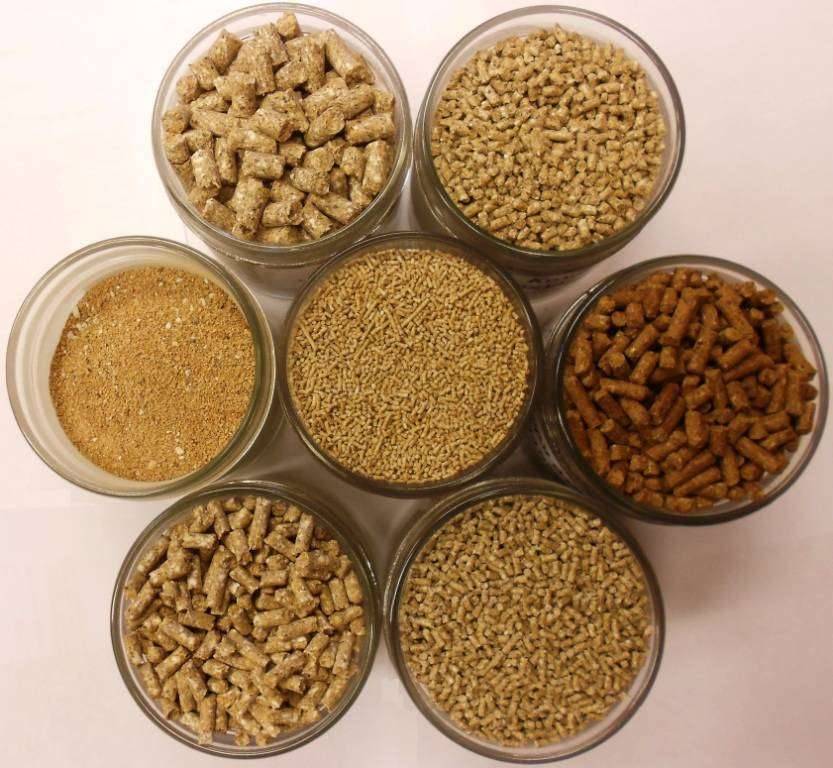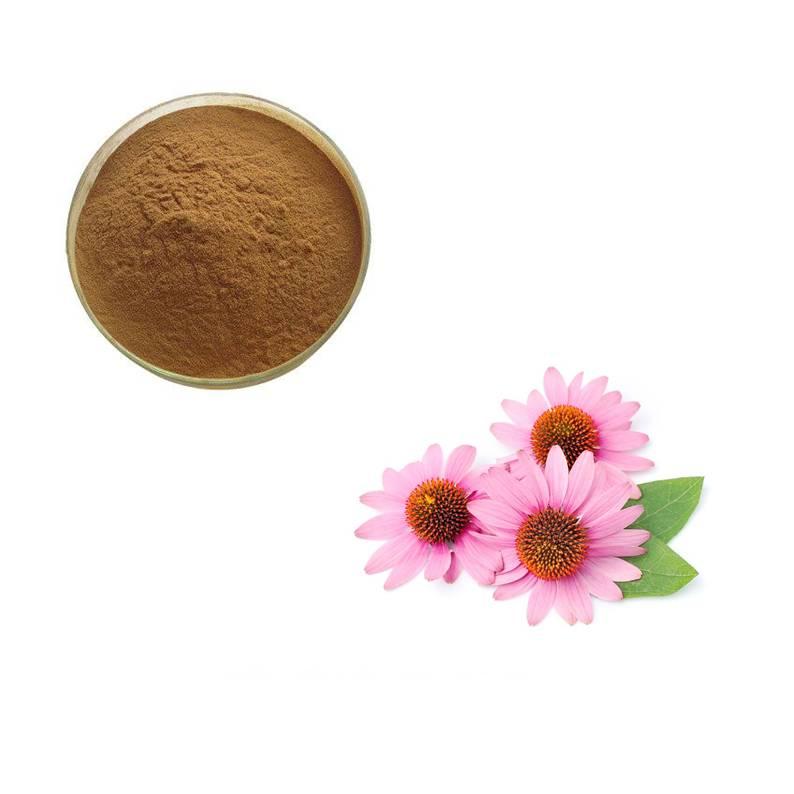What Is Echinacea Extract?
Echinacea purpurea (purple coneflower) is the dried root, stem, leaf and flower of the perennial herb Echinacea purpurea (purple coneflower) in the Asteraceae family. It is harvested in September, foreign matter removed, and then dried at low temperatures. Purple coneflower is a perennial wild plant in the North American prairies. It has been used as medicinal vegetation throughout North America and Europe for hundreds of years. Traditionally, it was used by Native Americans for many purposes, including bites from poisonous animals and other more extreme injuries.
In 1887, it was introduced into American medical practice, where it is used for everything from colds to viruses. Modern research on echinacea began in Germany in the 1930s. Echinacea extract (Echinacea Herb P.E.) is an extract obtained by extracting, concentrating and spray-drying the whole herb of the Echinacea purpurea plant in a 60% ethanol solution under a vacuum at 70 °C. It is currently an immune enhancer and regulator that is widely valued internationally. It can significantly improve the body's immune regulation level and is widely used in the West as an immune regulator and immunostimulant to improve immunity, treat colds and flu, fight infections, accelerate wound healing and reduce inflammation.

Researchers have found that the immunomodulatory effect of echinacea is related to the large amount of polysaccharides and phytosterols they contain. They have anti-bacterial, anti-viral, anti-fungal, anti-inflammatory, stimulate immune response, enhance immune system function, prevent influenza, promote wound healing, shorten the duration of the disease, and are mainly used to treat upper respiratory tract infections, typhoid fever, paratyphoid fever, bacterial infections, viral infections, mild to moderate infections, and severe mixed infections. It can be seen that purple daisy is a plant with high medicinal value. Currently, some domestic companies are already extracting it, but purple daisy, its extracts and preparations have not yet been included in the national veterinary drug standards, nor have the development and marketing of new veterinary drugs and their products.
1. The efficacy and distribution of echinacea and its extracts
Purple coneflower (Echinacea purpurea), also known as purple coneflower, purple coneflower, or purple coneflower, is native to the Americas and has high medicinal value. It is named after its capitate inflorescences, which resemble pine cones. The dried root is similar in shape to Sichuan lovage, thin and strip-shaped, brownish black, oily, light and fragrant, and sweet. Echinacea extract (Echinacea Herb P.E.) is an extract of the whole herb of the Asteraceae plant Echinacea purpurea. It is a brownish-yellow to brown powder with a slightly sweet aroma and a bitter taste. It is neutral in nature and enters the heart, lung and liver meridians. It is soluble in methanol, ethanol and water, but it absorbs moisture easily.
It should be stored in a cool, dry place away from light and tightly closed. It has good antiviral, antibacterial, antifungal and anti-inflammatory effects, and can strengthen the immune system, prevent influenza, shorten the duration of colds, promote wound healing, relieve pain and has multiple other effects. It can be used as an immunomodulator and immunostimulant and is widely used in health products, veterinary drugs, functional food additives and other fields. Currently, the main species being developed as medicines are purple coneflower (Echinacea purpurea), narrow-leaved coneflower (Echinacea augustifolia) and white coneflower (Echina- cen pallida). There are large areas of these plants being cultivated in Hubei and Shaanxi provinces, and they have also been introduced in Beijing, Shanghai and Nanjing. With the development of medicinal technology and planting technology, there have been more and more winter flowering cultivation methods and patents in recent years, which are favored by the domestic pharmaceutical planting industry.
2. Chemical composition of echinacea and its extract
The active ingredients of echinacea and its extracts are phenolic compounds, such as echinacoside, verbascoside, cichoric acid, caffeic acid, chlorogenic acid, isochlorogenic acid, etc., as well as various alkylamines, flavonoids, polysaccharides and a small amount of essential oil. The main ingredients are cichoric acid and polyphenols. Cichoric acid has the chemical name (2R,3R)-2,3-bis[[(E)-3-(3,4-dihydroxyphenyl)prop-2-enoyl]oxy]butanedioic acid, the English name (2R,3R)-2,3-bis[[(E)-3-(3,4-dihydroxyphenyl)prop-2 -enoyl]oxy]butanedioic acid, with the molecular formula C22H18O12 and molecular weight 474.37. Chicoric acid can inhibit hyaluronidase and HIV-1 integrase, and has the effects of promoting cell phagocytosis and antiviral activity in vivo and in vitro. It also has the effects of protecting the liver, antibacterial, anti-infection, and anti-allergy.
3. Pharmacological effects of echinacea extract
The polysaccharides and caffeic acid derivative polyphenols in purple daisy and its extracts can enhance the body's immunity by increasing granulocytes and leukocytes, enhancing T cell activity and the phagocytic capacity of macrophages, stimulating the immune response, strengthening the immune system, preventing influenza and shortening the duration of the disease, inhibiting hyaluronidase to promote the secretion of adrenocorticotropic hormone to inhibit influenza, viruses, bacteria and fungi, and have antibacterial, anti-infective and anti-inflammatory effects. It can be used for a variety of bacterial and viral diseases such as influenza, typhoid fever, paratyphoid fever, upper respiratory tract infections, bacterial infections, viral infections, moderate to mild infections, and severe mixed infections.
4. Clinical application and efficacy of echinacea extract
Purple daisy is the only deep immune substance in nature that has the effect of “bone marrow preservation” and significantly improves and maintains autonomous immunity. In clinical use, it has far surpassed interferon, transfer factors and vaccines. Only purple daisy can be called the “immune expert for the body's full recovery”.
4.1 Significantly improves the body's autonomous immunity and has the effect of “bone marrow preservation”
“Bone marrow preservation” improves the body's immune system from the source, allowing the immune system to function to the fullest. Echincea and its extracts have the unique ability to prevent and fight diseases, protect the body, and regulate the metabolic, circulatory, endocrine, and nutritional systems to return them to normal levels. This is something that no other immune agent, interferon, vaccine, Chinese herbal medicine, protein, etc., can do.
4. 2 Plant antibiotic effect ‘King of blood purification’ and ”blood purification
50% to 60% of diseases are caused by bacteria and viruses that infect various organs in the body. Echinacea and its extracts have a strong ability to kill bacteria and phagocytose bacteria in livestock and poultry. By phagocytosing bacteria or viruses, they prevent the bacteria or viruses from replicating and mutating, which leads to their own death. By phagocytosing, the contents of the bacteria or viruses leak out and the bacteria or viruses die. It has the effect of lysozyme and can quickly remove toxic substances, inflammatory components and metabolic waste, achieving the goal of purifying the circulatory system.
Tests have shown that when poultry suffer from a serious mixed infection of viruses and bacteria, 2000 broilers and 2000 layers are divided into four groups. Groups 1 and 2 are broiler groups, and groups 3 and 4 are layer groups (layers are not in the egg-laying period). Each group has 1000 birds. Group 1 and group 3 are given compound amoxicillin powder (specification 50g: amoxicillin 50g + clavulanic acid 1.25g) mixed with 10% shikimic acid, mixed drinking, 0.5g per 1L of water for the chickens, twice a day for 5 days. Groups 2 and 4 were given a mixture of 150 kg of water with 8 g of echinacea soluble powder (containing 8 g of echinacea extract and 10 g of paracetamol) to drink once a day for 5 days. There was no significant change after 4 days of treatment in groups 1 and 3. The effect of treatment began 6 hours after administration in groups 2 and 4, with a 6% reduction in mortality rate. Phagocytic ability increased 4.2 times on the 4th day, which is a complete substitute for some antibiotics such as amoxicillin, colistin sulfate, ampicillin and neomycin sulfate.
4.3 Tissue growth activation
Echinacea and its extract can promote the growth of fibroblasts, increase cartilage and bone collagen, promote tissue growth, promote wound healing, and relieve and alleviate symptoms such as coughing, phlegm, and difficulty breathing caused by respiratory infections in poultry. Diseases such as infectious laryngotracheitis (ILT) and infectious bronchitis (IB). Infectious laryngotracheitis (ILT) is an acute respiratory infectious disease caused by herpesvirus type A. The main symptoms of diseased chickens are difficulty breathing, neck stretching, mouth-wide-open breathing, head-down-neck-inhaling, coughing, head-shaking, and blood-mixed mucus-shaking out. The characteristic symptoms are runny nose and wet sounds when breathing, followed by coughing , gasping for breath, and finally suffocation and death due to blood clots blocking the larynx. The infectious bronchitis (IB) virus is mainly found in the respiratory tract and secretions of sick chickens. After an outbreak in a flock, the disease quickly spreads throughout the whole flock. Sick chickens are depressed, their feathers are fluffy, they shiver, pant, cough, sneeze, and have a raspy breathing sound. There is discharge from the nostrils. The disease mostly presents as a kidney-type lesion. Necropsy shows that the kidneys are enlarged, pale, and the entire kidney is covered with areca-like spots, hence the name “spotted kidney”. Purple daisy extract is used in the treatment of infectious laryngotracheitis (ILT) and infectious bronchitis (IB) in poultry, and it is even more effective when combined with ambroxol hydrochloride.
4. 4 Receptor occupation' antiviral effect
The antiviral effect of echinacea and its extract is completely different from the mechanism of action of conventional national antiviral drugs such as ribavirin, amantadine and rimantadine. The polysaccharide structure of purple daisy and its extract “occupies the site preferentially” and binds to the receptor site of the virus, so that the virus has no opportunity to bind to the receptor site or infect healthy cells. This antiviral method of echinacea and its extract, which competes for the receptor site, is safer, more effective, broader in spectrum and more rapidly. It can replace acyclovir, an antiviral drug used to treat herpes, as well as the broad-spectrum antiviral drug ribavirin. It can also replace amantadine and rimantadine, which are used to treat influenza and affect egg production. It can also replace the drug viramune (also known as morinidazole hydrochloride), which has a moderate antiviral effect and requires high doses. It can be used in combination with the drug astragalus polysaccharide, which is used to treat infectious bursal disease, , high-efficiency interferon inducers polyinosinic:polycytidylic acid, interferon, deoxyglucose (DG) in combination.

4.5. Antioxidant, anti-free radical and anti-inflammatory effects
Echinacea and its extract have antioxidant, anti-free radical and cardioprotective effects, can delay the body's resistance to fatigue, increase the body's load capacity, maintain strong energy, extend the egg-laying cycle, increase the body's resistance to disease, enhance the body's cellular antiviral ability, effectively inhibit and kill virus cells, and have antibacterial, anti-inflammatory and antiviral effects.
4.6. Other effects
Recent studies have found that echinacea and its extracts also have interleukin-like effects, activation of cellular immunity, activation of killer T cells, reduction of the toxic side effects of drugs, increase in disease recovery rates, immunostimulatory effects, reduction of inflammation and onset of inflammation and infection, reduction of the duration of avian influenza and other diseases, and can also be used to treat upper respiratory tract infections, typhoid fever and paratyphoid fever.
5. Optimal preparation process for echinacea extract
Orthogonal experiments were used to prepare the extract using drinking water, purified water, water for injection, ethanol solutions of different concentrations (40%, 60%, 80%, 95%), and ethyl acetate as solvents, with the solid-liquid ratio controlled at 1:3, 1:5, 1:6, 1:8, 1:10, 1:15, 1:20, respectively. The extraction temperature was room temperature, 45 °C, 65 °C, 80 ℃, 100 ℃ , soaking time is 3h, 5h, 8h, 10h, 12h, 24h, extraction times are 1, 2, 3, extraction time is 30min, 1h, 1.5h, 2h, respectively. The key points of the extraction process of echinacea whole herb were finally determined by orthogonal test: 60% ethanol purified aqueous solution for oral preparations, 60% ethanol injection water solution, solid-liquid ratio of 1:6, extraction temperature of room temperature 25℃ ±2℃, soaking time of 8h, extraction times of 2 times, extraction time of 1 h, the content of the active ingredient and technical parameters are optimal.
The whole herb of Echinacea purpurea can be directly crushed using a traditional Chinese medicine grinder and passed through a 60–80 mesh standard sieve to make a powder for direct feeding or mixing with feed. The 60% ethanol purified water extract can be concentrated and refined to make oral granules, oral liquids, internal solution preparations, mixtures, suspensions, sprays and infusions. The 60% ethanol injection water extract can be concentrated, ultrafiltered using a Millipore, and purified using supercritical extraction can be made into injection solutions of various volumes, freeze-dried powder injections and sterile powder injections. The extract can also be concentrated and made into an extract reserve by vacuum spray drying at 70 °C. It is used to prevent and treat respiratory tract infections, Escherichia coli infections, viral infections and mixed infections in livestock and poultry, and to improve the body's immunity, prevention, health care and treatment. It can also be used in combination with traditional Chinese veterinary drugs, chemical drugs and feed.
6. Future prospects for purple coneflower and its extracts
Echinacea has an immunostimulating effect, reduces inflammation, and helps the body fight bacteria and viruses. With the improvement of food safety and consumer demand for the quality of poultry products, the use of feed additives such as chemical growth promoters, antibiotics, hormones and other residues, drug resistance and environmental pollution will gradually be restricted, and even banned or eliminated. New, green, safe Chinese herbal medicines and their extracts will be increasingly valued and popularized.

However, the current scope of application of echinacea is relatively narrow, and it is still a blank in some livestock and poultry farming. Purple daisy is widely distributed in China and is cultivated on a large scale. Its active ingredients such as polyphenols have various physiological health care and disease prevention functions in the livestock and poultry industry, and have important application value. At present, foreign research has made great progress. In recent years, research on purple daisies in China has achieved some results, but they have not yet been widely promoted and used.
Echinacea Extract can be used as an immune regulator and immunostimulant. It has antiviral, antibacterial, antifungal and anti-inflammatory effects, can stimulate immune responses, enhance immune system function, prevent influenza, shorten the course of disease, accelerate recovery and rehabilitation, enhance immunity, improve immunity, prevent viral invasion, and effectively resist bacterial and prevent viral infections. In addition, echinacea extract can also be used as a feed additive in the livestock and poultry industry. Therefore, the application prospects are very broad, so it is worth further research and development and promotion in China, so that Chinese herbal medicine extracts can better contribute to the further development and utilization of the animal husbandry industry, fully demonstrating the advantages of China as a major breeding country and traditional Chinese medicine country.

-
Prev
How Does Green Spring Technology's Epimedium Extract Contribute to Innovation in Animal Nutrition Product Formulations?
-
Next
Green Spring Technology Provides Fully Traceable, High-Stability Epimedium Extract Solutions


 English
English French
French Spanish
Spanish Russian
Russian Korean
Korean Japanese
Japanese




